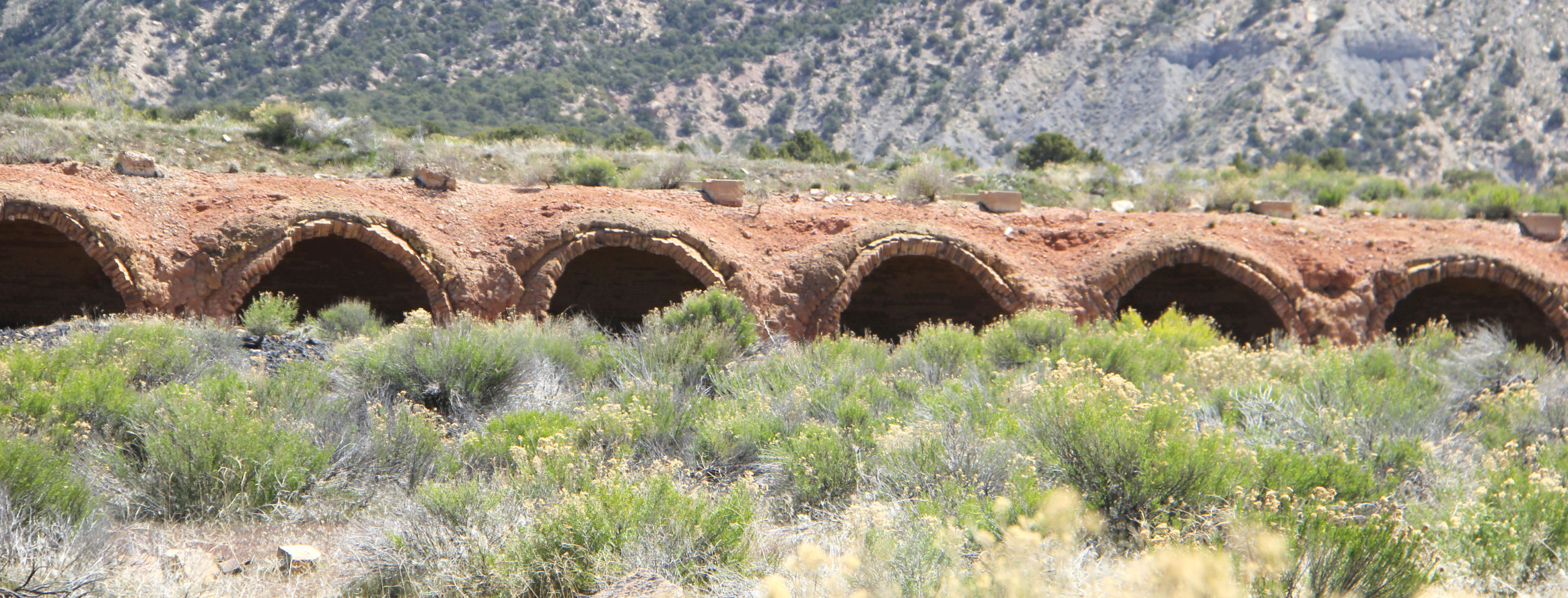The Emery County Historical Society went to Sunnyside and Dragerton Utah recently to see the coke ovens and learn something of the coke oven and mining history.
“In the early part of 1902, miners commenced building coke ovens. During that summer and fall, the first 200 ovens were completed. This was the starting point of the coke industry in Dragerton. At intervals, additional ovens were built and by 1918, 819 ovens were in operation. By the 1930s, the coke ovens sat idle, until Henry J. Kaiser opened 297 of them in the early 1940s to operate his steel mill. They were permanently closed in 1958. The Historical Society made a trek to see some of the original ovens that remain.”
Bernice Payne a leader of the Emery County Historical Society introduced Robert Potts of Price who was to lead the tour from Sunnyside City Park to explore some open coke ovens. Robert Potts had once been an employee at the Kaiser Steel coke ovens from 1957-1958. The ovens were closed down and Robert was laid off on Christmas Day 1958. Robert had some large group photos of employees taken in front of the coke ovens and a few books showing what the original coke ovens looked like. These books and photos came from the Carbon County Historical Society to help explain the history of the coke ovens used during World War II to make coke from coal. Coke is coal with all the impurities burned out of it. When the impurities burned out of the coal the hard residue is coke and about half the weight of coal. It is easier to ship coke to California steel mills than it was the much heavier coal. Kaiser Steel built and operated the coke ovens seen on the trek.
The coke delivered to California was used for smelting iron and steel in a blast furnace. A blast furnace uses air forced into the furnace to make the fire burn hotter. Coke with forced air produces a much hotter heat than coal. Coke can reach a temperature of 2500 degrees Fahrenheit.
That is the amount of heat required to melt steel. Coke is used for many kinds of smelting and is still used today. However there are not very many smelters left in the United States. Most of the smelting today is being done overseas in countries like China.
At one time there were 800 coke ovens East of Sunnyside Utah and 300 near Dragerton Utah. The 800 ovens have all been covered over with earth. The Columbia ovens were built during World War II near the Horse Canyon mine close to the coal for the coke ovens.
Potts said the government subsidized building the town of Dragerton. Dragerton was a town where the miners lived that worked the mine in Horse Canyon. Some of this coal was also delivered by rail cars to the Geneva Steel coke ovens at Orem.
Potts told the group the first coke ovens were built for the Utah Fuel Company and were located East of Sunnyside in 1900.
Kaiser Steel later purchased the coke ovens from Utah Fuel.
The coal mined out from the mountains on the East side of the Castle Valley was of a higher quality and made better coke than coal from the mountains on the West side of the valley.
This was because the coal from the mountains on the West side of the valley had too many impurities like resin in the coal.
The coke ovens seen by the Emery County Historical Society group were open for viewing by the public. The front wall of the ovens including the oven door had been removed to protect the public. The ovens were dome shaped about 15 feet tall and 15 feet wide with a flat bottom. When coal was loaded into the oven the coal would stand about three to four feet high.
The ovens were built in rows about one half mile long. In each row the ovens were placed back to back and side by side like two rows of eggs. At this site there were two rows of ovens about 50 feet apart.
When the ovens were working there was a rail line that ran along the top of the ovens. Rail cars loaded with coal would travel along the top of the ovens and stop over each two ovens to deposit coal through a round hole in the top of the oven. Another rail line ran along in front of the ovens at a lower level. When the coal had burned down to the coke residue, the oven door would be opened and the operator with a long rod having a L shaped hook on one end would rake coke out of the oven over a screen that separated the ashes from the coke. The coke was then scrapped into a wheel borrow. When the wheel borrow was full of coke the operator would push the wheel borrow up a ramp and dump the coke into the waiting rail car.
The Historical Society group members were able to drive their automobiles up near the open Coke Ovens situated on the mountain hillside between Sunnyside and the town of Columbia. They also saw the old abandoned Carbon County Railroad Company train station.
The Carbon County Railroad Company started with three miles of track and later added seven miles of track for hauling coal from the Horse Canyon Mine to the coke ovens. One end of the track was tied into the main line to transfer cars loaded with coke for California.
Historical society visits coke ovens

A row of historic coke ovens near Dragerton are part of the local mining history. Phil Fauver, Staff Writer
